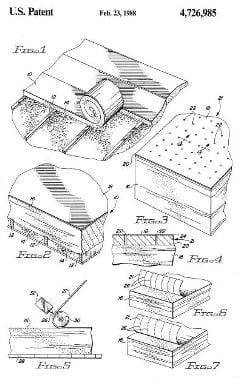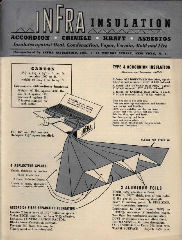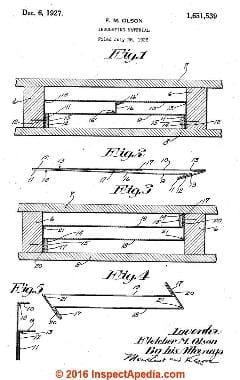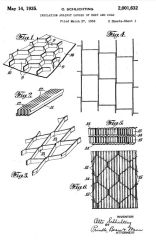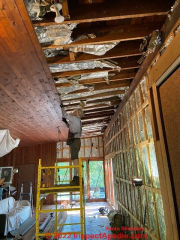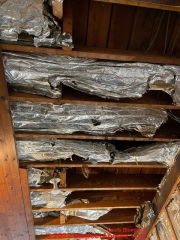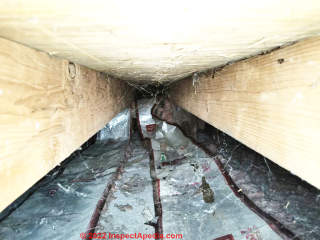 Reflective Insulation: properties, uses, technical data
Reflective Insulation: properties, uses, technical data
- POST a QUESTION or COMMENT about reflective insulation used in buildings, mechanical systems, & other locations;
Reflective insulation:
Properties, R-values, & uses of reflective insulation in buildings and in other applications. Where is reflective insulation used? Where is reflective insulation actually useful or effective?
This article describes the properties & uses of reflective insulation in buildings and other applications.
InspectAPedia tolerates no conflicts of interest. We have no relationship with advertisers, products, or services discussed at this website.
- Daniel Friedman, Publisher/Editor/Author - See WHO ARE WE?
Foil-based Reflective Insulation material identification, insulation R-values, insulation characteristics, applications, & technical data
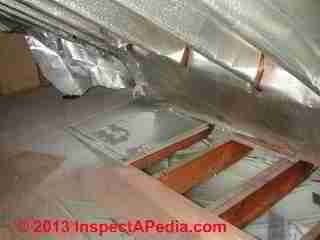 What's the difference between RADIANT BARRIERS [a separate article]
What's the difference between RADIANT BARRIERS [a separate article]
and REFLECTIVE INSULATION [discussed on this page]?
[Click to enlarge any image]
Watch out: In understanding insulation, radiant barriers, and reflective insulation products, it's worth noting that you may find products labeled as "insulation" that are a simple single thickness aluminum foil radiant barrier, and you may find insulating blankets covered with aluminum or even kraft paper and aluminum labeled as a radiant barrier product. It's confusing.
A radiant barrier works principally by serving as a single layer of aluminum foil, possibly reinforced with fibers or paper backing, used to reflect heat outwards (keep the attic cooler) or inwards towards the building interior (avoid losing heat, keep the building warmer).
Reflective insulation is a similar insulating and energy conserving product that adds an air cushion, usually in the form of plastic bubble material, between layers of aluminum foil to improve the insulating value or R-value of what would otherwise be a simple radiant barrier.
We expand on these definitions at the end of this article.
Thickness & composition distinguish among radiant barriers (thin) and reflective insulation (thicker) and foil faced insulation (much thicker)
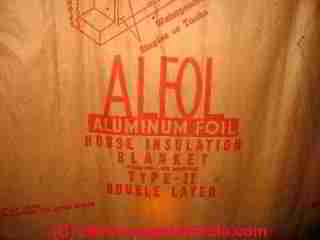 Some radiant barrier products may comprise multiple layers of aluminum foil or foil plus paper.
Some radiant barrier products may comprise multiple layers of aluminum foil or foil plus paper.
While the air layer trapped between these layers improves the R-value of the product, in our OPINION, products less than 1/4" in thickness remain, in our book, a radiant barrier.
Products that are made up of at least two layers of aluminum foil, separated by bubble or other material that is 1/4" thick or slightly thicker are reflective insulation.
The double-layer kraft and aluminum "ALFOIL house insulation blanket" shown at left works principally as a radiant barrier.
As we discuss at RADIANT BARRIERS, " Dead air trapped between the double layers of foil above the kraft paper provided a slight increase in the R-value of this product."
Still thicker insulating products, such as foil faced fiberglass insulating batts that are 1" or more in thickness, we refer to as foil faced insulation, not simple reflective insulation that will be described further here.
How is Reflective Foil Insulation Constructed - what layers, what materials?
Reflective insulation is usually made using two layers of aluminum foil that has been laminated or "glued" to the surface of two layers of plastic "bubble wrap" or air bubble material.
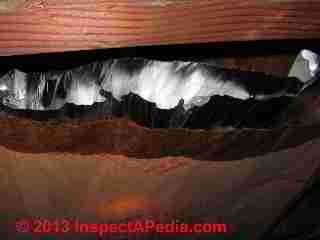 Or in some older reflective foil building insulation such as the "Double Layer" ALFOL Type II Double Layer insulating product shown at left, you may find as many as four layers comprised of
Or in some older reflective foil building insulation such as the "Double Layer" ALFOL Type II Double Layer insulating product shown at left, you may find as many as four layers comprised of
- Kraft paper (outer layer, printed with the company's information (at the bottom in our photo)
- A doubled layer of kraft paper, possibly coated on one side with a bituminous moisture barrier
- Two or more layers of aluminum foil (at the top in our photo).
In newer reflective insulation constructed using a layer of bubble wrap, the rounded surface of the air bubbles keeps the two layers of foil separated and the individual bubbles, by trapping or enclosing air, ensure that there is a still-air insulating barrier between the two surfaces of foil, thus improving the R-value of the reflective insulating material.
The bubble-trapped air means that no air movement by convection should occur within the reflective insulation. Such air currents would reduce or even eliminate the R-value of insulation just as air currents in walls, floors, or ceilings will increase heat transfer through those structures.
When used under a roof or in an attic floor (not our first choice), the aluminum foil on both surfaces of the reflective insulation means that the same insulation layer will reflect heat outwards (back towards the roof) from the upper surface of the reflective insulation in summer, and it will reflect heat downwards or inwards (back towards the building interior) during the heating season.
Common Uses of Reflective Building Insulation
Unlike RADIANT BARRIERS that were used in lieu of fiberglass, mineral wool, or foam insulation in building floor, wall, or ceiling cavities, reflective foil based bubble-interior building insulation is not used in modern residential construction as the primary cavity insulation material. Rather the product is used in more industrial settings and in special applications as we list here:
- Animal barns, poultry buildings, stables
- Commercial buildings, garages, workshops
- Concrete curing blankets
- Garage door lines
- HVAC duct wrap, especially as a retrofit product
- Packaging for products that need to be protected from temperature extremes during shipping
- Storage facilities
- Survival blankets
- Temporary-occupancy buildings such as temporary jails or shelters
- Transportation truck and trailer cargo liners
- Window coverings or insulating window shades
- And in these special applications:
- reflective insulation boards or blankets behind freezers, woodstoves [watch out, overheat risk, may not be UL approved]
- behind radiators
- behind refrigeration and air conditioning coils inside of HVACR equipment
Properties & R-Values of Reflective Insulation Products |
||
Property |
Single Air Bubble Layer |
Double Air Bubble Layer |
| R-value [b] | 4.9 | 5.0 |
| Reflectivity | 0.96-0.97 | 0.96-0.97 |
| Permeability | effectively zero for foil | effectively zero for foil |
| Emissivity | 0.03-0.04 | 0.03-0.04 |
| Fire Rating | Class A/Class 1 | Class A/Class 1 |
| Temperature Exposure | -60F - 180F | -60F - 180F |
| Puncture resistance | 63 psi | 66 psi |
| Weight per sq. ft. | 0.8 oz | 1.25 oz |
Notes to the table above
- [a] Based on industry standard sheet [on file];
- [b] R values obtained from a C236 hot box test.
- See BUBBLE / CLOSED-CELL FOAM SHEETS
- See HEAT LOSS R U & K VALUE CALCULATION
Watch out! these ratings were taken from the entire building cavity including the surrounding air space and thus reflect the R-value of the wall, floor, or ceiling the cavity represented, not the R-value of the material itself. Because building construction and air leak properties vary widely, we question these numbers.
The original document for double air bubble layer reflective insulation: 15 (D), 7.31 (H) and 5.4 (U), and for single bubble layer reflective insulation 14.5 (D), 7.0 (H), and 4.9 (U).
Question: do some reflective barrier products contain asbestos
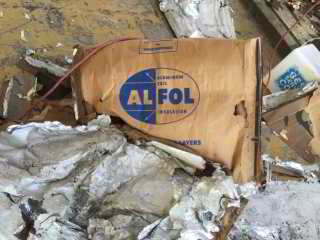 I have been researching the internet for information regarding asbestos in reflective insulation:
I have been researching the internet for information regarding asbestos in reflective insulation:
Images attached.
We have a small baby and construction was going on while she was very little. So I am trying to find out the likelihood of this material containing asbestos?
Do you have any information other than this post on your web site? - Anonymous by private email 2017/12/12
Reply: Yes some but not all reflective barrier products included asbestos cloth, paper, or boards.
Researching an answer to your question we found that particularly in the U.S. between the 1930's and early 1960's a number of reflective barrier insulation products included asbestos paper or in other forms as both a reinforcement, for fire resistance, or for heat resistance.
I have added that information in this article at REFLECTIVE INSULATION RESEARCH.
Here is a typical example
The composite insulation of the invention comprises two or more sheets of insulating material such as metal foil, laminated metal foil and paper, asbestos, plastic, or paper. (Alexander et als 1957)
Note: By this information I am NOT claiming that the Borg Warner Type II ALFOL aluminum foil + kraft paper reflective insulation shown above in your photo is an asbestos-containing product. Patents from Borg Warner involving insulation were focused on the refrigeration industry (not cited here).
Other reflective barrier products patented by General Dynamics and other companies described insulating products included a variety of heat reflecting insulating materials whose patent disclosures did not include the word "asbestos". (Clay 1970).
Question: identification of reflective insulation vs. radiant barriers
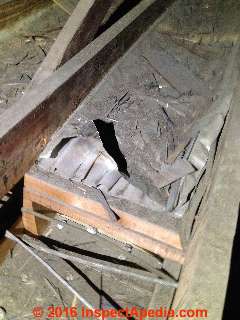 Can you by any chance help me identify this type of insulation ? I have never seen it before. Thank you in advance.
Can you by any chance help me identify this type of insulation ? I have never seen it before. Thank you in advance.
I myself would like to learn more about this stuff since it is the first time i have ever seen it and i am curious and would like to learn more. I spent many hours trying to find any thing about this product to no avail please send me a link to the thread so i can follow along . - Anonymous by private email, 2016/10/23
[Click to enlarge any image]
The reflective insulation shown above was found by the reader and is reported to be installed in a single family home in Altadena California. The home was built in 1951.
Reply:
Looks to me like an early radiant-barrier type "insulation" product. I'm unsure what sort of paper was used inside the foil to give it more air space and thus improve its insulating rating.
On the off chance that the paper is an asbestos product, I'd take care not to make a dusty mess. We discuss reflective insulation such as your product here on this page.
Separately, at RADIANT BARRIERS we discuss a similar product, radiant barriers, another reflective product.
What's the difference between reflective insulation and a radiant barrier? It depends on your information source, as not everyone will speak with equal precision.
Watch out: it's possible that the paper baffles shown in the reflective insulation in your photograph are asbestos paper.
Definition of radiant barrier
A radiant barrier is a single sheet of reflective foil used to reduce unwanted heat loss or unwanted heat gain by placing a heat reflecting material at a strategic location. In buildings, that's typically in an attic and most often on the under-side of roof rafters or on the upper side of an attic floor.
A radiant barrier might also be placed in a wall or over a basement or crawl area. Historically aluminum foil but perhaps reflective mylar in more recent applications.
Definition of Reflective Insulation
Reflective insulation improves on the concept of a radiant barrier by using two or more layers of heat reflecting material, typically bound together to form a blanket. The blanket may be simply hollow or it may contain internal baffles such as shown in our reader's photograph above. However you'll note that except for material used to provide individual air chambers, reflective insulation is hollow.
Reflective Barriers on Other Insulating Products
Other fiberglass insulating products are sold with a non-reflective kraft-paper facing that also aids insulation installation as well as sold as unfaced fiberglass batts. Products that combine a reflective barrier with fiberglass or another insulating material may be referred to as "reflective fibrous insulation" (Fay 1988).
Foil-faced fiberglass insulation is a more-widely-used contemporary insulating product found in building roofs, ceilings, attics, walls, floor.
This product combines a foil faced paper on one side of the insulation. The foil facing improves the insulation's performance by reflecting heat as well as by serving as an air barrier, and the facing also aids in insulation installation by providing a paper flange that can be stapled to the building framing rafters, ceiling joists, wall studs, or floor joists.
Unlike reflective insulation, foil-faced insulation combines the foil facing with a thickness of insulating material, typically fiberglass batts.
Research on Reflective Insulation
 While the insulating properties of multi-layer or multi-wall metallic materials are reflected in earlier patents ca. 1900, a surge of multiple-layer metallic reflective insulating materials began in the United States in the 1920's, possibly with the development of improvements in the economical production of thin aluminum sheeting or foils.
While the insulating properties of multi-layer or multi-wall metallic materials are reflected in earlier patents ca. 1900, a surge of multiple-layer metallic reflective insulating materials began in the United States in the 1920's, possibly with the development of improvements in the economical production of thin aluminum sheeting or foils.
- Alexander, Schwartz, and Fogelson Emile. "Thermal insulation." U.S. Patent 2,777,786, issued January 15, 1957.
Excerpt:
The composite insulation of the invention comprises two or more sheets of insulating material such as metal foil, laminated metal foil and paper, asbestos, plastic, or paper.
The insulation may be formed entirely of one sulation of continuous sheets or webs of more or less indefinite length and to connect the edge portions of the sheets to supporting other when installed, and a means for attaching the insulation in the place of use, such as to the framing structure of a refrigerator, box, building, or the like. - Alexander, Schwartz, and Fogelson Emile. "Thermal insulation." U.S. Patent 2,750,313, issued June 12, 1956.
Excerpt:
The composite insulation of the invention comprises two or more sheets of insulating material such as metal foil, laminated metal foil and paper, asbestos, plastic, or paper. - Andrews, Bernard R. "Heat-insulating-wall construction." U.S. Patent 1,522,708, issued January 13, 1925.
- Benedict, Edward L. "Thermal insulating building unit." U.S. Patent 2,101,836, issued December 14, 1937.
Illustrated at above / left.
Abstract: This invention relates to thermal-insulating building units, that is to means for thermally insulating structures of all sorts suchas houses, ships and the like, and has for its object to provide a unit for such use which is easier to handle and place in position as well as easier to ship than are the present thermal insulating units.
One objection to the use of metal foil has been the inconvenience in handling and shipping it or else the inconvenience in inserting it. One suggestion contemplated the foil being attached to a foundation for giving it strength.
If the foundation is rigid and easy to insert between studs, beams or other framing members, it is not convenient for shipment. On the other hand, if the foil'is mounted on paper and made easy for shipment in rolls, considerable labor expense is required to properly space and mount the foil sheets between the framing members.
It has been customary to crumple up foil sheets and mount them between the framing members. Theobjection to this practice is that the spacing and therefore the efiiciency of the spaced foils will not be uniform and in fact there is not enough certainty that the foils will be spaced apart everywhere. Metal foil is so light and thin and easily torn that its insertion in a building has not been considered altogether easy.
Under this invention metal foils are mounted in pairs with an intermediate foundation and the unit being constructed so that it is easier to assemble and insert in place, yet unusually well adapted for shipment without danger of being torn. Referring to the drawing Fig. 1 shows a folded insulating unit according to this invention.
As shown in Fig. 3, between studs, beams or framing members Ill and II is mounted the thermal-insulating unit l2 of this invention. This unit comprises an accordion plaited foundation I3 having the plaits arranged longitudinally of the unit and spacing layers of metal foil 14 and 15 attached to the foundation.
The foundation 13 may be of paper, preferably about a seventy pound paper (that is, a ream of sheets 24" by 36" weighs lbs.) although heavy metal foil or a metal foil mounted on paper might be used, or where fireproof construction is desired an asbestos or other fireproof paper is suitable.
The metal foil layers l4 and 15 are preferably aluminum foil about .0003 inch thick although the foil of other metals may be used, the aluminum foil being preferable.
Also see ASBESTOS INSULATION - home. - Bynum, Rick, AIA, A BRIEF HISTORY of THERMAL INSULATION [PDF] (2000) retrieved 2021/08/12 original source: https://azaranstore [dot] com/download/articles/434%20insulation%20handbook.PDF
- Clay, J., and V. Lintvedt. "Method of insulating." U.S. Patent 3,806,391, issued April 23, 1974., Assigned to General Dynamics
ABSTRACT OF THE DISCLOSURE
An insulation material comprising a thermal heat reflecting material such as aluminized polyester film, viz, Mylar, provided with a multiplicity of fiber tufts of flocking material spaced apart and bonded to the Mylar in a substantially polka-dot pattern. The upstanding fiber bristles serve to space the reflecting material away from adjacent structure or other adjacent layers of insulation.
Heat transfer by conduction is reduced to a minimum as a result of the tufts of bristles being in point contact only with adjacent material and structure. - Eldredge, Merrill J. "Building construction." U.S. Patent 2,054,694, issued September 15, 1936.
Includes citation of use of asbestos in Celotex wallboard products:
Excerpt:
My invention consists of taking I-beams l, 2 and 3 and setting them spaced apart with panels A formed by securing sheets of insulation material 4 onto sheets of thin metal 5 and then securing the panels to the I-beams.
The insulation may be any of the type of insulation wall boards, such as might be made of fullers earth, or like material, or of a fibrous nature or with porous gypsum, or asbestos fiber and other compositions. One type of these wall boards is sold on the market under the trade name of Ceotex.
- Fay, Ralph M., and Theodore R. Rohweder. REFLECTIVE FIBROUS INSULATION [PDF] U.S. Patent 4,726,985, issued February 23, 1988.
Abstract:
A laminate of foil and kraft paper is adhered to the upper face of fiber glass insulation so that the exposed foil reflects radiant heat entering the attic through the roof of a building structure.
Relatively thick kraft paper supports the very thin layer of foil without causing a fire hazard due to the use of an inorganic adhesive, such as sodium silicate, to bond the two together and also due to the use of a fire retardant water-based adhesive to bond the foil-kraft laminate to the fiber glass.
The laminate is preferably perforated to prevent it from functioning as a vapor barrier. - Hnilicka, M. P. "Engineering aspects of heat transfer in multilayer reflective insulation and performance of NRC insulation." In Advances in Cryogenic Engineering, pp. 199-208. Springer US, 1960.
- Al-Homoud, Mohammad S. "Performance characteristics and practical applications of common building thermal insulation materials." Building and environment 40, no. 3 (2005): 353-366.
- Ghahremani, A. Moayed, and E. Freel Singleton. "Reflective insulation blanket with retaining clips." U.S. Patent 4,590,727, issued May 27, 1986.
- Guo, W., X. Qiao, Y. Huang, M. Fang, and X. Han. "Study on energy saving effect of heat-reflective insulation coating on envelopes in the hot summer and cold winter zone." Energy and Buildings 50 (2012): 196-203.
Illustration: Infra Insulation's 1947 catalog, courtesy of an InspectApedia reader suggestion.
- Infra Insulation, INFRA INSULATION ACCORDIAN CRINKLE KRAFT ASBESTOS [PDF] (1947) Infra Insulation, Inc., 10 Murray St. New York, NY, retrieved 2022/09/08 original source: https://ia802505.us.archive.org/31/items/infra-insulation-1947-a/Infra%20insulation%201947%20A_text.pdf
In 1945, Alexander Schwartz, president of Infra Insulation, Inc. out of New York City, commercially produced a radiant barrier reflective insulation product he called INFRA Insulation. It was designed to keep summer heat out and winter heat in a home or building.
Architects and builders immediately embraced this solution as a way of building higher energy efficient homes. Infra Insulation, Inc. quickly became the largest producer of reflective foil insulation.
In the 1950’s, INFRA Insulation was introduced to the consumer market as an accordion-fold style product and was touted as easily installed by anyone who could use a staple gun. Newspaper advertisements even depicted women installing the radiant barrier in their own homes.
By the early 1960’s, millions of square feet of radiant barrier had been installed in homes and buildings. Unfortunately, an unfavorable FTC ruling against Infra Insulation Inc., coupled with Schwartz’ untimely death in the early 1960’s put an end to any further expansion.
By 1965, his INFRA Insulation radiant barrier product was taken off the market entirely and the business closed. - (RIMA International 2022 - cited below)
There may have been an earlier recording, but we found, in the Index of Trademarks issued by the U.S. Patent Office, that
Infra Insulation, Inc., New York, N.Y. was issued a trademark for Cellular Insulating fabric, 542,321, May 15, Serial No. 578,265, published Feb. 6, 1951. Class 12. - Infra Insulation, in Journal of Applied Physics, Vol. 20, February 1949, p. 232,
Infra Insulation, Inc., 10 Murray Street, New York 7, New York, has published a 32-page manual by Alexander Schwartz, president of the company, on Simplified Physics of Thermal Insulation. It covers heat transfer, condensation, vermin, mold, fire, radiant heating, and other facts and factors involved in the study of insulation and insulating values. Copies free on request. - Ladon, Aaron A. "Thermal insulation media." U.S. Patent 1,983,617, issued December 11, 1934.
Excerpt:
In addition to flat bright metal wire strands or ribbons incorporated in fabric form in the usual fashion, I may also employ bright metal strips or ribbons wound spirally on strands or cords of other material; cotton or asbestos e. g. Such combined fibrous and metallic strands being woven into suitable fabric form. - Low-I A HISTORY of FOIL INSULATION [PDF] Low-I Reflective Insulation, Inc., 48 Weaver Ind. Est, Blackburne Street Liverpool, L19 8JA, United Kingdom E: info@low-e.co.uk T: +44 (0) 151 494 9994 - retrieved 2022/09/08, original source: https://low-e.co.uk/blog/a-history-of-foil-insulation/
- Olson, Fletcher M. "Insulating material." U.S. Patent 1,726,040, issued August 27, 1929.
- Olson, F.M., 1927. Insulating material. U.S. Patent 1,651,539. [Shown below]
Excerpt:
The perpendicular orgrades, saturated felt, asbestos, or the like. [... sec]tions of the sheets 9 and 10 forming the aps
- Otto, Schlichting. INSULATION AGAINST LOSSES of HEAT or COLD [PDF] U.S. Patent 2,001,632, issued May 14, 1935.
Excerpt:
It is known to employ for insulating purposes layers of air which are limited by bright heat- 5 reflecting metal foils spaced by means of asbestos cords, asbestos board, or wire constructions. - REFLECTIVE INSULATION R-VALUES [PDF] from ASHRAE Fundamentals. [table giving R-values for reflective insulation in different positions]
- RIMA, International, Reflective Insulation Manufacturers' Association, PO Box 14174
Lenexa, KS 66285
Toll-Free: (800) 279-4123 Web: https://rimainternational.org/
Alexander Schwartz Award - retrieved 2022/09/08, original source: https://rimainternational.org/news/alexander-schwartz-award/ - SISALKRAFT REFLECTIVE INSULATION CATALOG 1950 [PDF]
- Schwartz, Alexander, and Emile Fogelson. "Thermal insulation." U.S. Patent 2,786,004, issued March 19, 1957.
Excerpt:
The composite insulation of the invention comprises two or more sheets of insulating material such as metal foil, laminated foil and paper, asbestos, plastic, or paper, and may be formed entirely of one of these sheet materials or of combinations thereof.
In accordance with our invention, we prefer to form the insulation of continuous sheets or webs of more or less indefinite length and to connect the lengthwise edge portions of the sheets together forming reenforced edge strips which provide a means for attaching the insulation to a supporting or framing structure. - Wheeler, Donald B., "Heat reflective insulation." U.S. Patent 2,879,554, issued March 31, 1959.
Abstract excerpt:
the present invention'relates to a heat reflective in sulation. More particularly it covers an insulation which can be made up in collapsed form and can be conveniently expanded and mounted in a building to provide a minimum of two and a maximum of four layers of air spaces, each of which may have a reflective surface.
This application is a continuation-in part,of my cc,- pending application, Serial No. 665,821, filed Jun'14', 1957, and a continuation-in-part of my copending application Serial No. 720,873, filed March 12, 1958, - Zupon, Lawrence, David Dejarlais, James Gambatese, and Stephen Neff. "Reflective insulation." U.S. Patent 6,797,356, issued September 28, 2004.
Abstract:
A reflective insulation system.
The reflective insulation system includes a reflective layer such as aluminum, a layer of fiberglass, and a layer of vapor retarding material. A first side of the layer of fiberglass is bonded to the reflective layer by a deposit of hot melt glue.
The second side of the layer of fiberglass is bonded to the layer of vapor retarding material by a second deposit of hot melt glue. The vapor retarding layer may be a plastic material, such as polypropylene or a reflective material, such as aluminum.
...
Reader Comments, Questions & Answers About The Article Above
Below you will find questions and answers previously posted on this page at its page bottom reader comment box.
Reader Q&A - also see RECOMMENDED ARTICLES & FAQs
On 2022-09-08 by Anonymous by private email (mod) - asbestos test report for reflective foil insulation & felt backing
@InspectApedia-911,
 Good news, I sent the mysterious kraft paper inside of aluminum insulation last weekend to CA asbestos lab. I just got the results and the report says there are no asbestos detected.
Good news, I sent the mysterious kraft paper inside of aluminum insulation last weekend to CA asbestos lab. I just got the results and the report says there are no asbestos detected.
I also included the other fiber insulation ( it appears to be rockwool ) of asphalt paper to check. This rockwool was tucked in at only small area.
The result was also none asbestos detected.
What a relief! Please see attached report. I want to believe the report is telling me that samples are safe from asbestos but fine notes are bit confusing.
We looked any brand or product id on the aluminum insulation. But there are none.
Can’t tell if this product was Infra insulation but it could still be a good reference for “reflective insulation" to any homeowners have wonders like me.
Thank you so much for your advice and your website. It is truly helpful for homeowners like us!
Here is a copy [redacted for privacy] of our
ASBESTOS TEST REPORT for REFLECTIVE FOIL INSULATION & FELT BACKING [PDF]
On 2022-08-30 by InspectApedia-911 (mod) - simple paper-backed foil insulation sheet
@Anonymous by private email,
These look to me like simple reflective insulation - described above on this page. There is simply a foil, or paper-backed foil sheet stapled under rafters or under floor joists.
I don't see any fiberglass or other insulating material -
If you confirm that there is no insulating material, just foil, then you're on the right page. So do let me know if I've understood your photos correctly.
On 2022-08-30 by Anonymous by private email
Altho I couldn’t find our insulation in your category….
Could you identify type of insulation shown attached photos below?
We have mid-century house located in Mid-Hudson Valley NY, built around 1956-57. All wooden structure.
In the process of removing wall and ceiling wood boards we discovered thin aluminum foils accordion like insulation, have blue grey paper in-between the foils stapled in between the joists & studs. The paper inside is deteriorating and creating lots of dust removing them.
DO you think is this paper contain the asbestos? Should we send out for lab test? We appreciate your advice. - KB by private email
On 2022-08-17 by InspectApedia-911 (mod) - foil covered pink fiberglass insulation
@Ronnie,
INSULATION IDENTIFICATION GUIDE
Should be of some help to you. You've posted on a page that describes simple thin single sheet aluminum foil reflective insulation but you've now identified that what you actually have is a fiberglass insulating product.
The R value that you give is quite reasonable once corrected.
You'll see that the insulation manufacturers have been using the same color product for many decades. But you might be able to find a lot number or production number stamped somewhere on the facing.
On 2022-08-17 by Ronnie
@InspectApedia-911,
Upon closer inspection the R value is 9.6. The product also has a red stripes on both sides. The insulation has fallen down from between the joists and is lying on the plastic vapor barrier. There is no water source in the room above it.
This is an addition on a 1955 home in upstate NY. Using old aerial maps, I know the addition was not present when the home was built, but was added before 1969.
Other photos I was able to get show words saying "this side towards..." and I can't read the rest, and "Aluminum Foil" in red hollow lettering. I believe it's an Owens Corning product but from what decade? Hope some more details help. Thanks.
On 2022-08-16 by InspectApedia-911 (mod)
@Ronnie,
No simple foil insulation alone would get an R-value of "96" so we're missing something here.
What are the country and city where the building is located?
How old is the building?
(None of that framing looks very old but I think I see some leak stains).
On 2022-08-16 by Ronnie
I am trying to figure out the approximate age of the insulation in a crawl space. It is reflective foil with pink fiberglass insulation. It has what looks like R-96 and 3 1/8 stamped on it. From what I can make out the words "fiberglass".
It's in a crawl space that was built in the 60s but I am not sure the insulation is original to that era. To date I have not found access to the crawlspace other than the several gaps between joists as shown in photo.
Determine the age or era of this insulation will help me figure out if someone did get access after it was built. (so I'll need to look under the carpet). Thanks.
On 2021-07-15 by inspectapedia.com.moderator - use of asbestos in Alfol
@Gus johnson,
Thank you for that historic information and background on the use of asbestos in Alfol. It will be helpful to other readers and researchers. Give us the years as well if you can.
On 2021-07-15 by Gus johnson
I installed Alfol for 3 years while attendingUniv. Of Miami and worked for Reflectal a# a sales rep in N Yfor 3 years before they were sold to Borg Warner ? Asbestos was only used with foil attached to one side for stoves and back of radiators , 1A, 2,3and 4 had foil layers with a moisture barrier Attached Togo on the inside of the homes
On 2020-10-10 by danjoefriedman (mod)
That's interesting, Andrew.
NO I have not found research on the R-value or reflectance of multiple layers up to 20 of foil-faced bubble wrap, nor have I found any manufacturer or other source recommending or even considering that approach.
On 2020-10-10 by Andrew
I was interested in the calculations behind the multilayer Reflectance insulations such as ATIUS, SF40 in your research have you found any formula that would enable a value to be derived for say 20 layers of foil coated bubble wrap?
...
...
Continue reading at RADIANT BARRIERS or select a topic from the closely-related articles below, or see the complete ARTICLE INDEX.
Or see these
Recommended Articles
- COOLING LOAD REDUCTION by ROOF VENTS
- HEAT LOSS R U & K VALUE CALCULATION
- RADIANT BARRIERS
- REFLECTIVE INSULATION
- ROOF COLOR RECOMMENDATIONS
- HEAT LOSS R U & K VALUE CALCULATION
- INSULATION INSPECTION & IMPROVEMENT - home
- INSULATION R-VALUES & PROPERTIES - R-values & U Values of various materials
Suggested citation for this web page
REFLECTIVE INSULATION at InspectApedia.com - online encyclopedia of building & environmental inspection, testing, diagnosis, repair, & problem prevention advice.
Or see this
INDEX to RELATED ARTICLES: ARTICLE INDEX to BUILDING INSULATION
Or use the SEARCH BOX found below to Ask a Question or Search InspectApedia
Ask a Question or Search InspectApedia
Try the search box just below, or if you prefer, post a question or comment in the Comments box below and we will respond promptly.
Search the InspectApedia website
Note: appearance of your Comment below may be delayed: if your comment contains an image, photograph, web link, or text that looks to the software as if it might be a web link, your posting will appear after it has been approved by a moderator. Apologies for the delay.
Only one image can be added per comment but you can post as many comments, and therefore images, as you like.
You will not receive a notification when a response to your question has been posted.
Please bookmark this page to make it easy for you to check back for our response.
IF above you see "Comment Form is loading comments..." then COMMENT BOX - countable.ca / bawkbox.com IS NOT WORKING.
In any case you are welcome to send an email directly to us at InspectApedia.com at editor@inspectApedia.com
We'll reply to you directly. Please help us help you by noting, in your email, the URL of the InspectApedia page where you wanted to comment.
Citations & References
In addition to any citations in the article above, a full list is available on request.
- "Controlling Moisture in Log Homes" and the more general (but brief) DOE article series on moisture control:
- "Minimizing Air Leakage in Log Homes"
- "Ventilation", U.S. DOE, describes the purpose of building ventilation and three basic ventilation strategies:
- WEATHER RESISTIVE BARRIERS [PDF] U.S. Department of Energy, ", how to select and install housewrap and other types of weather resistive barriers
- "Vapor Barriers or Vapor Diffusion Retarders", U.S. DOE: how vapor barriers work, types of vapor diffusion barriers, installing vapor barriers
- ASHRAE resources on building insulation, dew point and wall condensation - see the ASHRAE Fundamentals Handbook, available in many libraries. The following three ASHRAE Handbooks are also
- 1996 Ashrae Handbook Heating, Ventilating, and Air-Conditioning Systems and Equipment: Inch-Pound Edition (Hardcover), ISBN-10: 1883413346 or ISBN-13: 978-1883413347 ,
"The 1996 HVAC Systems and Equipment Handbook is the result of ASHRAE's continuing effort to update, expand and reorganize the Handbook Series. Over a third of the book has been revised and augmented with new chapters on hydronic heating and cooling systems design; fans; unit ventilator; unit heaters; and makeup air units. Extensive changes have been added to chapters on panel heating and cooling; cogeneration systems and engine and turbine drives; applied heat pump and heat recovery systems; humidifiers; desiccant dehumidification and pressure drying equipment, air-heating coils; chimney, gas vent, fireplace systems; cooling towers; centrifugal pumps; and air-to-air energy recovery. Separate I-P and SI editions." - Principles of Heating, Ventilating, And Air Conditioning: A textbook with Design Data Based on 2005 AShrae Handbook - Fundamentals (Hardcover), Harry J., Jr. Sauer (Author), Ronald H. Howell, ISBN-10: 1931862923 or ISBN-13: 978-1931862929
- 1993 ASHRAE Handbook Fundamentals (Hardcover), ISBN-10: 0910110964 or ISBN-13: 978-091011096
CONTINUE READING or RECOMMENDED ARTICLES.
- Carson, Dunlop & Associates Ltd., 120 Carlton Street Suite 407, Toronto ON M5A 4K2. Tel: (416) 964-9415 1-800-268-7070 Email: info@carsondunlop.com. Alan Carson is a past president of ASHI, the American Society of Home Inspectors.
Thanks to Alan Carson and Bob Dunlop, for permission for InspectAPedia to use text excerpts from The HOME REFERENCE BOOK - the Encyclopedia of Homes and to use illustrations from The ILLUSTRATED HOME .
Carson Dunlop Associates provides extensive home inspection education and report writing material. In gratitude we provide links to tsome Carson Dunlop Associates products and services.



